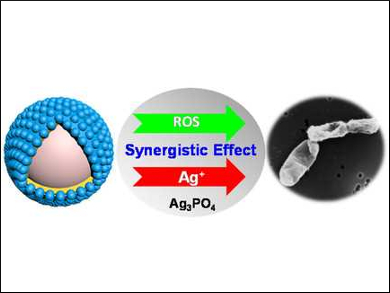With the rise of multidrug-resistant bacteria, developing new antibacterial materials is an important research target. Bo Bai, Qinghai University, China, Sheng Dai, Newcastle University, Newcastle upon Tyne, UK, and colleagues have developed antibacterial core/shell/shell SiO2/ZnO/Ag3PO4 nanoparticles.
The team used a simple reflux method for the sequential deposition of ZnO (pictured yellow) and Ag3PO4 (pictured blue) onto SiO2 spheres (pictured beige). Under visible-light irradiation, the nanoparticles showed an improved antibacterial activity against Escherichia coli compared to Ag3PO4 or SiO2/ZnO nanoparticles. The outer membrane of the bacteria collapsed after mixing them with the nanoparticles and exposing them to light (pictured right).
Silver ions are known to have an antibacterial effect, but quantitative analyses showed that silver release is only a minor cause of the particles’ antibacterial activity. The researchers demonstrated that radical oxygen species (ROS) make major contributions to the anti-E. coli activity. Thus, the enhanced antibacterial activity of the nanoparticles can be attributed to the synergistic effect of ROS and silver ion release.
- Synergistic Enhancement in Antibacterial Activity of Core/Shell/Shell SiO2/ZnO/Ag3PO4 Nanoparticles,
Pei Zheng, Bingyang Zhang, Bo Jin, Weisheng Guan, Bo Bai, Sheng Dai,
ChemNanoMat 2018, 4, 972–981.
https://doi.org/10.1002/cnma.201800195



